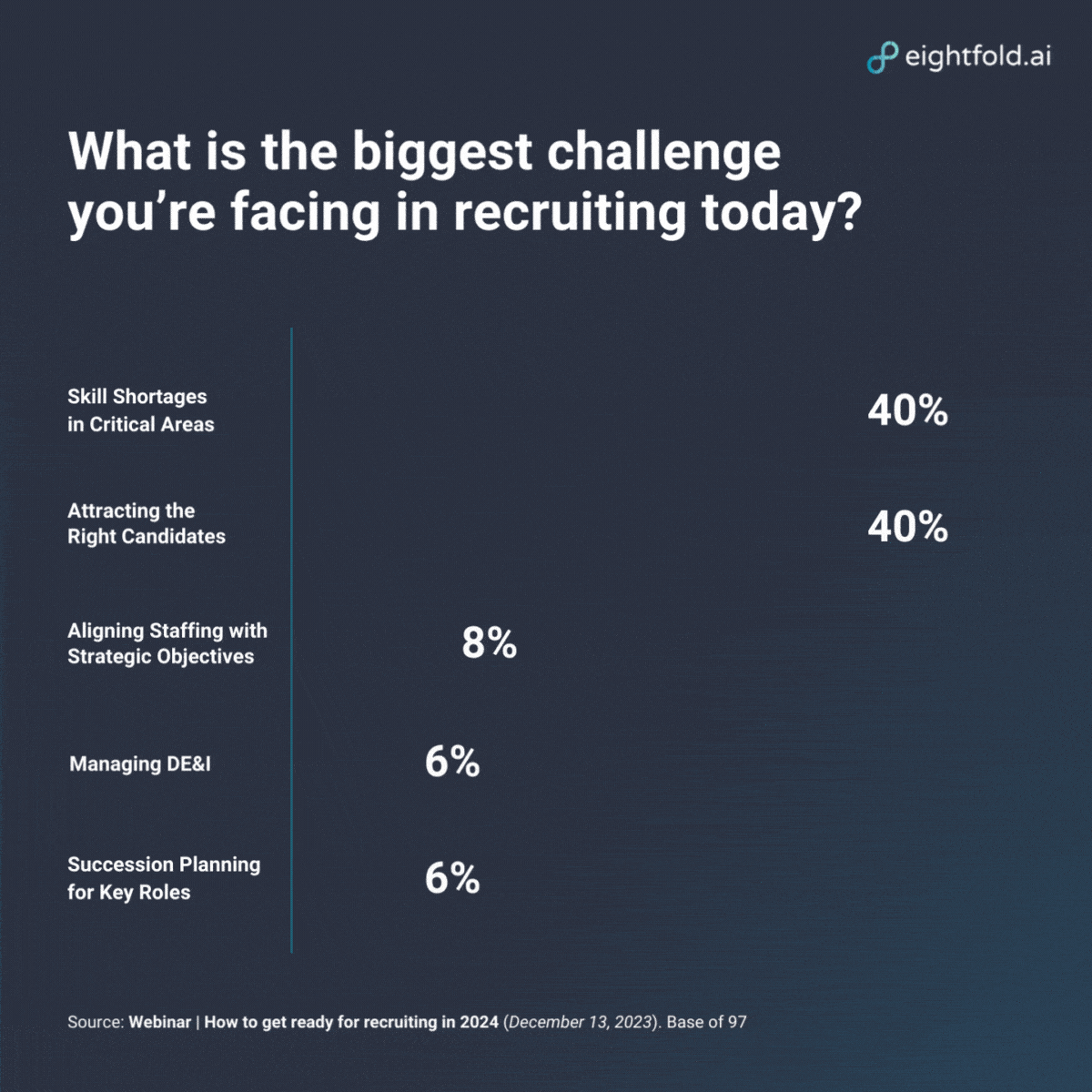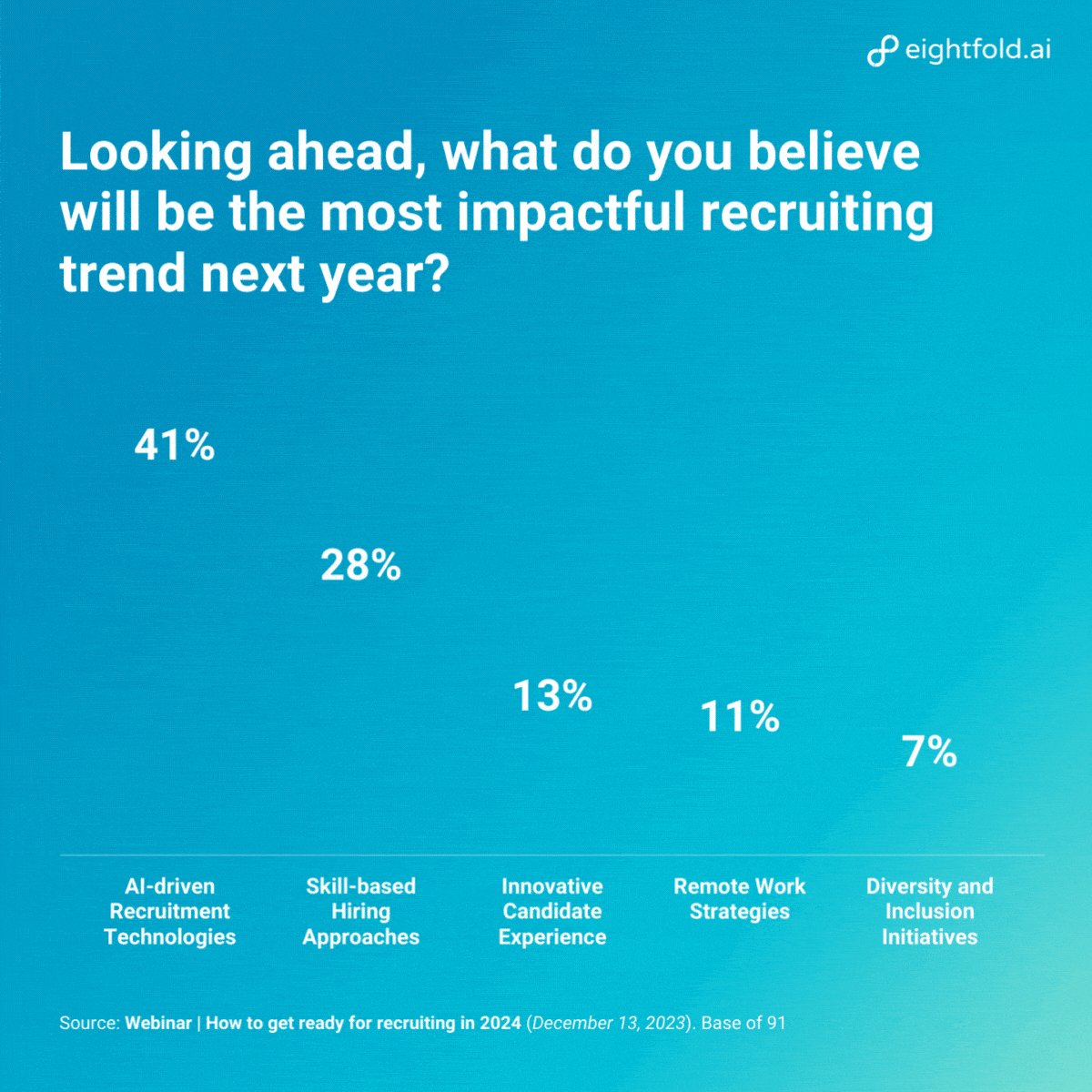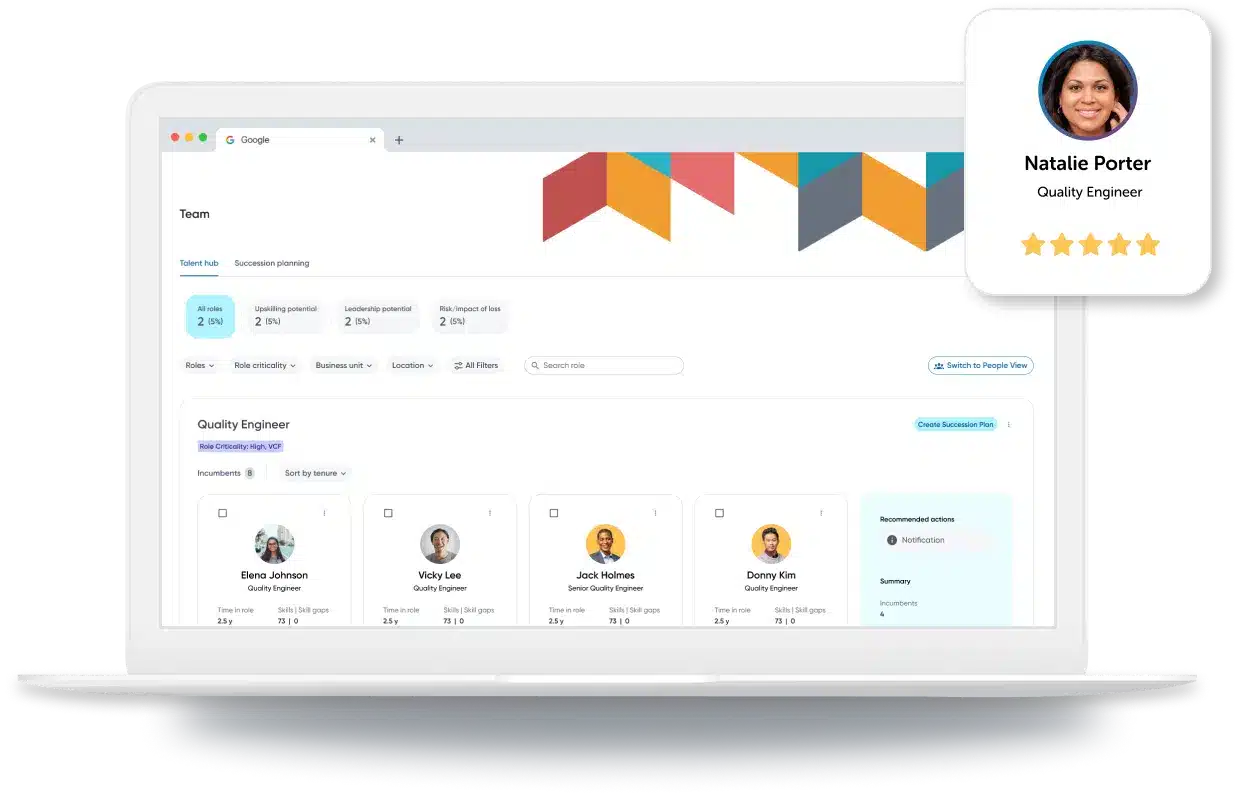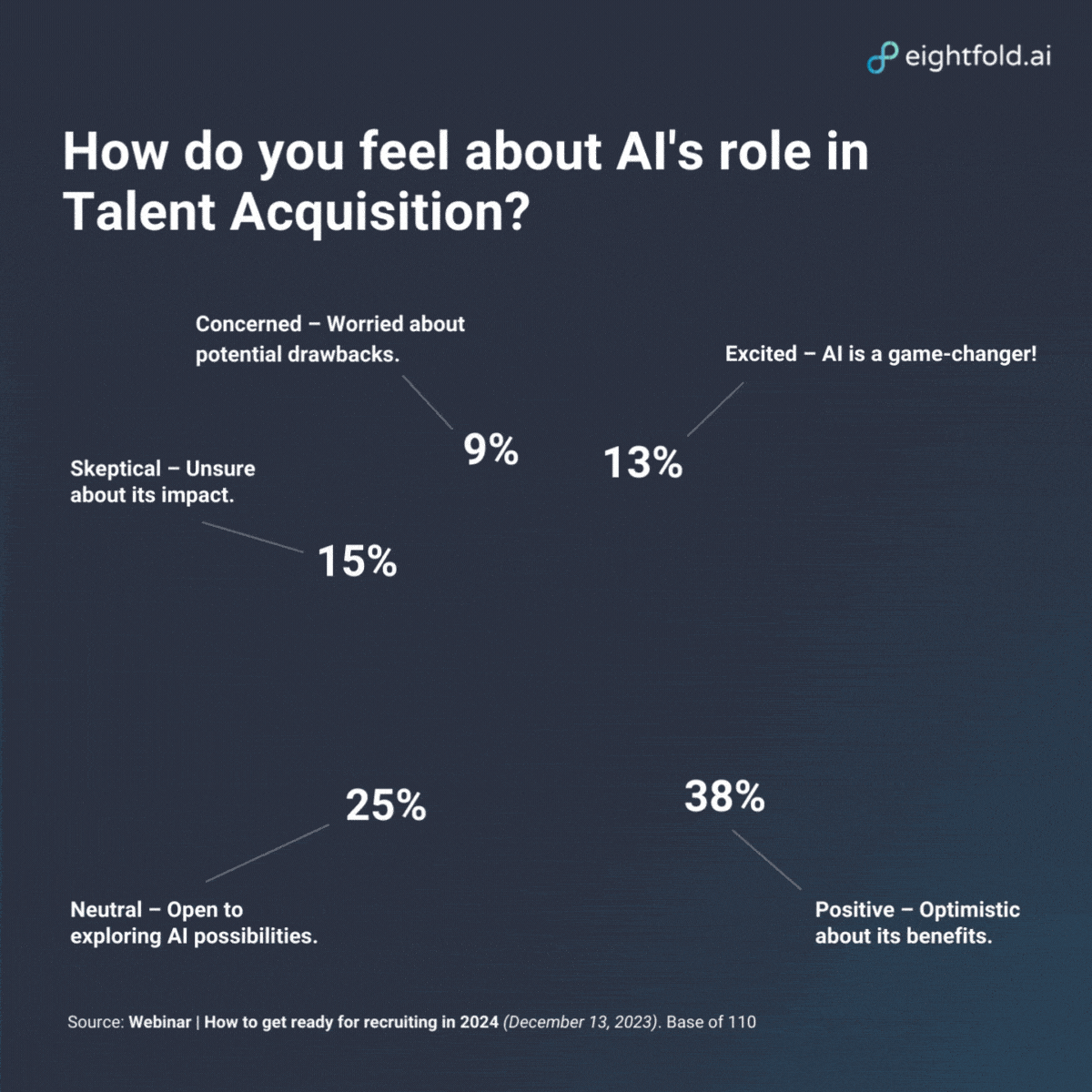- Skills shortages and attracting top candidates are the biggest challenges facing recruiters this year.
- Talent acquisition teams will prioritize a skills-first approach using talent intelligence.
- Success will require TA teams to be deliberate in hiring and focus on attracting employees with the right skills for today and tomorrow.
Staying current with the latest talent acquisition trends is challenging, especially with evolving methods and technologies, including new recruiting approaches and AI-based systems. But as the current job market remains highly competitive, TA leaders — and their organizations — need every advantage when it comes to finding the right talent.
Recruiters who anticipate changes and take calculated action will be able to find talent faster and ensure they’re ready for the challenges ahead.
In a recent webinar, I spoke with Matthew Couret, Director of Client Delivery at Coit Group, a Hudson RPO Company, about the top challenges facing recruiters and TA leaders in 2024. In this article, I’ll highlight the top two priorities for recruiters this year and beyond, and share four predictions to help you build a flexible and adaptable workforce that will go the distance.

Related content: Watch the entire webinar, “How to get ready for recruiting in 2024,” now on demand.
Top challenges facing recruiters in 2024
If I asked you about your top challenges in recruiting, what comes to mind? When we asked our webinar guests this question, 40% cited skills shortages and 40% said attracting the right candidates.

Understanding the biggest challenges facing recruiters — and how to overcome them — is vital for guiding your organization in timely and effective hiring. Without this understanding, you may find it difficult to secure top talent, resulting in missed opportunities, skill shortages, and bad hires.
Couret said that skills shortages in critical areas are going to continue to be one area that we see a lot of across our customer canvas.
As a recruiter or TA leader, you must identify immediate skills gaps and anticipate future needs while adapting to changing job markets and new technologies. This year will require that you enhance strategic workforce planning, look beyond immediate hiring needs, anticipate future skill demands, and formulate strategies to meet them.
Given that only 57% of our webinar attendees expressed mild confidence in their organization’s capability to evaluate an employee’s potential beyond what is presented on a résumé, there is room for improvement.

Addressing skills shortages requires several things. First, you’ll need an understanding of whether the shortage is from a mismatch between what hiring managers believe they need versus the actual job skills.
Secondly, new technology and AI are reshaping the recruitment landscape, introducing challenges and opportunities. Concerns about candidate privacy, ethics, and the potential for algorithmic bias can prevent you from fully embracing these tools — but they shouldn’t. The right solutions trained on ethical and responsible AI can actually reduce bias.
However, even as new technology and AI provide practical methods to improve processes and decision-making, it’s important to strike a balance. As a recruiter, you can harness the advantages of AI-driven talent insights (more on this later) while maintaining transparency and fairness.
Finally, evolving candidate expectations will shape recruitment approaches. With 51% of employees considering leaving their current roles, the perception of abundant job opportunities is increasing. This heightened competition is prompting organizations to offer attractive job packages and actively engage in recruitment efforts.
With candidates now valuing growth opportunities, work-life balance, and alignment with organizational values, you’ll need to put your best foot forward to recruit the right talent this year.
Let’s look at two top priorities for recruiters in 2024.

Priority No. 1: Building a skills-based organization
Everyone is talking about a skills-based organization, but what is it exactly? In these organizations, the talent life cycle revolves around skills. The emphasis is on identifying, developing, and using every employees’ unique skills, allowing for greater flexibility in task allocation, project assignments, and career progression.
Skills-based organizations prioritize and structure operations around the workforce’s specific skills and competencies rather than traditional job titles or roles. By focusing on skills over fixed roles, these organizations can quickly adjust to changes, encourage ongoing learning, and better deploy talent across different projects.
Plus, employees often don’t realize that their skills for one job can be easily transferred to another role — nor do many employers.
For example, let’s look at a customer service agent’s job. By looking at skills overlaps, you can identify agents who might also excel in sales or technical-support roles. This approach allows you to efficiently train and transition employees between departments based on their demonstrated skills and aptitudes rather than being confined by their initial job title or role. This flexibility maximizes employee potential and increases job satisfaction and boosts your ability to quickly adapt to changing needs.
To succeed in 2024, you’ll need to take a skills-driven approach, allocate responsibilities according to necessary expertise, and efficiently use a blend of existing and emerging talent.
Priority No. 2: Powering HR with talent intelligence
Identifying and hiring the right candidates without data and insights is like investing in the stock market without doing any research. You might make some lucky bets, but without informed analysis, you’re more likely to make costly mistakes and hire the wrong candidates.
Talent intelligence platforms help you make informed recruitment decisions. By using insights from billions of global talent data points, you can gain a deeper understanding of the job market, candidate preferences, and skills trends, helping you make decisions based on facts, not hunches.

Put simply, talent intelligence gives your team the information to understand the needs of tomorrow. For instance, your organization might identify a growing demand for a specific programming language among cloud engineers, yet there’s a shortage of experts. Recognizing this trend, you can adjust your recruitment approach, emphasizing upskilling initiatives to bridge the skills gap.
When considering roles like a cloud engineer, there might be more feasible options than waiting for a candidate with 100% proficiency, especially if the technology is relatively new. Instead, hiring someone with 70-80% of the required skills offers a solid foundation. With ongoing training and support, your organization and the new hire benefit, ensuring a mutually beneficial transition into the role.
4 recruitment predictions for 2024

Tackling a new year’s worth of talent challenges might feel daunting, but it doesn’t have to. Prepare your hiring team by understanding where the tides of recruitment are flowing. Here are my four predictions for talent acquisition:
1. Organizations will hire more deliberately
Success will require understanding your recruitment goals. Organizations that are intentional and selective in hiring processes will achieve greater success and alignment with strategic objectives.
Prepare now by:
- Focusing on understanding your organization’s goals by looking at what skills you need for the future.
- Being more deliberate in your hiring.
- Identifying opportunities where internal employees can be redeployed for vacant positions.
2. Talent attraction will start to focus more on skills
The shift toward a skills-first focus in talent attraction will enhance the alignment of candidates’ abilities with specific job requirements, allowing organizations to plan workforce strategies and stay competitive.
Prepare now by:
- Refining job descriptions to emphasize necessary skills over solely educational or experiential requirements.
- Collaboratively designing training initiatives with employees to address and bridge identified skills gaps. Remember to help them understand how the role can be performed and what unique value they bring to the organization.
3. Hybrid work arrangements will cause friction
As organizations strive to balance remote and on-site work, recruiters must address the challenges of hybrid work setups.
Prepare now by:
- Recommending employers consider the value of employees being in office — and when that time is necessary or required, using it wisely. Hold brainstorming sessions, team meetings, lunch and learns, among other opportunities, instead of focusing on compliance to a set number of days onsite.
- Encouraging employees to think about what they want to accomplish when they are in the office, for example, focusing on projects that can benefit from collaboration and building relationships with colleagues rather than back-to-back virtual meetings.
“Career paths continue to be one area that needs improvement because individuals are hired within the roles that are needed, but there’s not always enough foresight about what comes next.”
— Matthew Couret, Director of Client Delivery, Coit Group, a Hudson RPO Company
4. Career development will shift to personalized AI-driven plans
AI-powered talent intelligence can analyze the careers of millions of people to help create robust employee development plans and programs. Not only will this scalable employee development capability increase employee satisfaction, but it will also help organizations strategically acquire missing or vital skills through guided upskilling.
Prepare now by:
- Using talent insights to integrate AI-powered career pathing tools that evaluate unique skills, ambitions, and learning preferences, delivering personalized development insights and growth opportunities for every employee.
- Offering customized individual career paths so employees can control their personal development rather than a top-down approach where organizations dictate progression.
Prepare for recruitment success in 2024
The year ahead is a huge opportunity to embrace AI-powered talent intelligence and prioritize skills-based hiring, positioning your recruitment strategies for success.
By using talent insights to identify skills gaps and build a proactive recruitment approach, you can directly address challenges, prioritizing specific skills over generic job descriptions for a more precise and effective talent acquisition strategy.
Ready to learn more about how AI-powered talent intelligence can help you recruit top talent in 2024? Watch the webinar here or sign up for a demo.
Rebecca Warren is Director, Customer Success, at Eightfold AI.










